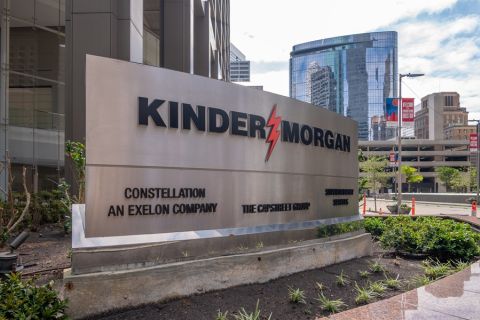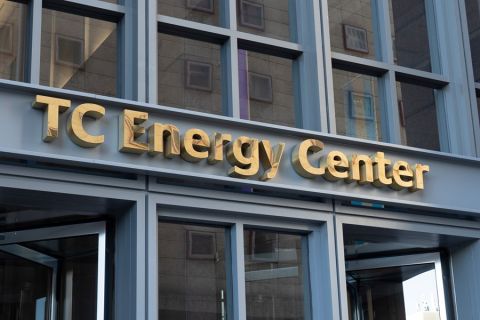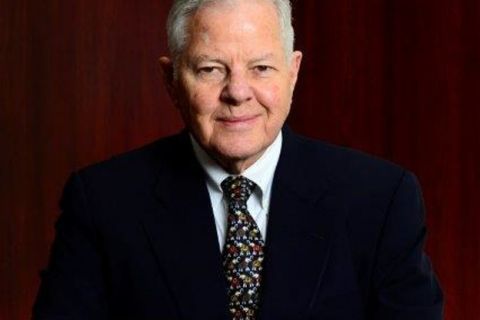The partners in the North Caspian Sea production-sharing agreement have finally declared the giant Kashagan discovery commercial. Kashagan, the world's largest discovery in 30 years, is operated by Agip, and lies in 10 feet of water some 47 miles southeast of Atyrau in the Kazakh sector of the Caspian Sea. The consortium, which has just completed a two-year appraisal program, estimates Kashagan contains recoverable reserves of 7- to 9 billion barrels of oil. If associated gas is reinjected, that range could increase to up to 13 billion barrels of oil. Meanwhile, the partners are continuing to explore other structures in their PSA area. This year, the Kalamkas prospect, a large structure that extends across portions of blocks 1, 4b, 5a, 6a and 8a, will be drilled. Kalamkas lies some 50 miles southwest of the Kashagan exploration area. In 2003, the Kashagan South West, Aktote and Kairan prospects will be tested. Agip is already building two artificial islands for the Aktote and Kairan locations, which are east of Kashagan, between it and the giant onshore Tengiz Field. Each feature has the potential to be another world-class discovery. North Caspian Sea consortium members are Agip, BG Group, ExxonMobil, Inpex, Phillips, Shell and TotalFinaElf. 1 Canada Three offshore exploration wells are currently being drilled on Canada's East Coast, reports Calgary-based consulting firm Canadian Discovery Ltd. ChevronTexaco Canada's new deepwater well, the Chevron Newburn H-23, is about 43 miles southwest of Sable Island. That test is about 3,300 ft. from its projected total depth of 20,992 ft. Conoco reports that it has farmed into the project, and will earn a 20% stake in the EL2359 block by taking part in the Newburn well. Marathon's deepwater Annapolis G-24 well is also nearing its projected total depth of 19,313 ft. Both deepwater wells appear to be targeting deep turbidite prospects, which have a collective estimated ultimate gas potential of 5- to 25 trillion cu. ft. of gas. Additionally, Canadian Superior Energy and partner El Paso Oil & Gas are drilling ahead on CSE's shallow-water Marquis prospect, after a July spud. The Marquis L-35 well is projected to reach a total depth of 16,728 ft. in approximately 70 days. The Marquis prospect is a Jurassic Abenaki reef play 16 miles northeast of Encana Corp.'s offshore Deep Panuke Field, a 1-trillion-cu.-ft. discovery that has recently entered the development proposal phase. 2 Canada Calgary-based Real Resources has announced another new oil pool discovery in the Neutral Hills area of east-central Alberta. The discovery well, drilled in the Provost Field area in late May, encountered a 20-ft. oil column in the Cretaceous Dina Formation that was production tested at rates of more than 100 bbl. of 30-degree-API oil per day. The pool will be delineated by several wells, followed up by potential infill locations. This is the fourth Dina oil pool discovery in which Real has participated at Neutral Hills during the past year and the second in 2002. Real has extensive 3-D seismic coverage in the area, which has proven to be very reliable in identifying anomalies in the Dina. Real also plans to drill a number of exploratory locations to test additional Dina 3-D seismic features on land it controls. 3 Canada Dallas-based The Wiser Oil Co. has had success with its Wild River prospect in west-central Alberta, says Canadian Discovery. The company has gas discoveries from two new pool wildcats, at 12-21-57-24W5 and 8-9-57-24W5, drilled earlier this year. Wiser recently completed those wells and recompleted its nearby 2-32 well, drilled in 2000. Production testing of the three wells yielded a gross combined test rate of some 15 million cu. ft. of gas per day. Both new wells were drilled to a total depth of approximately 9,900 ft. in the Jurassic Fernie formation and were targeting multizone Cretaceous sandstone reservoirs in this Deep Basin field. The discovery establishes new pool production in a lightly explored region of the field that previously had only a single producing well, the Wiser 2-32 well. The company is currently constructing pipelines and a new compression facility to handle the anticipated production. Wiser is planning to initiate a multiwell development program in the first half of 2003. 4 Canada Nexen Canada drilled an exciting new oil discovery in the Williston Basin in southern Saskatchewan earlier this year: a new pool wildcat to 7,893 ft. in the Silurian Interlake Group. Recently released production information shows the Nexen Bryant 7-4T-5-7W2 well is producing at an impressive rate of 1,370 bbl. of oil per day. The discovery is particularly noteworthy given the Interlake producing interval. Although the Silurian Interlake does produce in the U.S. portion of the Williston Basin, the Nexen 7-4T well is the first well in Canada's portion of the basin to produce from the Silurian section. Production is suspected to be from a fractured, dolomitized interval in the upper part of the Interlake carbonate succession. 5 Falkland Islands An international group has been awarded 10 license blocks, comprising 57,000 square kilometers, to the south and east of the Falkland Islands for an initial three-year period. Australian firm Global Petroleum Ltd. will operate and hold a 50% interest in the blocks; U.K. independent Hardman Resources Ltd will hold 30%; and Falkland Islands Co. will hold the remaining 20%. The licenses are in the South Falklands Basin, an underexplored area comparable to the Malvinas and Magallanes basins in Argentine waters to the west of the Falklands, Hardman reports. 6 Norway TotalFinaElf received the approval of the Norwegian government to develop Skirne and Byggve fields in Production License 102 in the south-central North Sea. The gas and condensate fields will be on production by year-end 2003, and by 2004 are expected to be producing at the rate of 34,000 bbl. of oil equivalent per day. TotalFinaElf operates PL 102; its partners are Petoro, Marathon and Norsk Hydro. In separate activity, Marathon has acquired interests in two Norwegian production licenses from Norsk Hydro. The company will operate PL 203 with a 65% interest, marking its first Norwegian operatorship, and will be a partner in PL 150 with a 50% interest. The licenses are west and southwest of Heimdal Field, respectively. 7 Egypt Houston-based Apache Corp. has made a second deepwater discovery on its 2.3-million-acre offshore West Mediterranean concession. The Al Bahig-1X well, 37 miles offshore in 3,510 ft. of water, was drilled to a total depth of 8,050 ft. in the Pliocene Kafr El Sheik formation and encountered a 247-ft. gas column. At this time, the company does not plan to test the discovery, which lies about 10 miles southwest of its recent Abu Sir discovery. Apache operates the concession and holds a 55% contractor interest in the deepwater portion; RWE-DEA has a 28.33% contractor interest; British Petroleum holds the remaining 16.67%. Also, Apache reported a flow test of 3,200 bbl. of oil and 7.7 million cu. ft. of gas per day from a well on its onshore Khalda concession in the Western Desert. The Tut 51 tested 54 ft. of pay from three intervals between 11,480 ft. and 11,993 ft. in the Khatatba formation; another 108 ft. of pay remained behind pipe. Additionally, 36 ft. of pay was encountered in the Bahariya zone at a depth of 6,100 ft. Apache operates Khalda with a 100% contractor interest. 8 Angola ChevronTexaco has made its eighth discovery in deepwater Block 14. The Gabela-1 well was drilled in 1,051 ft. of water to the south of the 2001 Tombua discovery. The well encountered 676 ft. of hydrocarbon column, and produced at the rate of more than 1,000 bbl. of 17.3-degree-API oil per day. Kuito, the first discovery on Block 14, was made in 1997; it was followed by Landana, Benguela and Belize, Tomboco and Lobito, and Tombua. The company is currently developing Benguela and Belize fields, which in 2005 are expected to produce at the rate of 200,000 bbl. of oil per day. ChevronTexaco owns 31% of the block; Sonangol, Agip and TotalFinaElf each have 20%; and Petrogal has 9%. 9 China Partners CNOOC and Husky Oil have begun producing oil from Wenchang 13-1 and Wenchang 13-2 fields, in the Pearl River Mouth Basin, at the rate of 20,000 bbl. of oil per day. The fields, which contain 21 wells, lie seven kilometers apart in 120 meters of water, and are being produced from two fixed platforms and one floating production, storage and offloading vessel. Recoverable oil is estimated at 83 million bbl. Production is expected to peak at 50,000 bbl. of oil per day. 10 Australia A consortium comprised of Woodside Petroleum, Anadarko Petroleum and EnCana Corp. has been awarded Exploration Permit 31 in the Duntroon Basin off South Australia for a six-year term. The Duntroon Basin is relatively unexplored: the 5,592-square-kilometer tract has only been drilled once. In 1993, BHP drilled the Greenly 1 to a total depth of 4,803 meters and abandoned it after recording oil and gas shows, reports IHS Energy Group. The Middle Cretaceous Platypus formation was the primary objective. The partners plan to reprocess 2,950 kilometers of seismic data during the first year of the license. Onshore South Australia, Beach Petroleum has already had success in the first well in its four-well exploration program in the Cooper Basin. The Sellecks-1 well flowed at the rate of 1,780 bbl. of oil per day from a 13-meter interval between 2,058-71 meters in the Patchawarra formation. The well was drilled in Petroleum Exploration License 92. Projected total depth was 2,205 meters. Australia-based Beach owns a 75% interest in the Sellecks well and Cooper Energy NL owns the remaining 25%. The drilling program is being carried out within an 85-kilometer radius of the Moomba production facility.
Recommended Reading
Kinder Morgan Nominates Deloitte’s Amy Chronis to Board
2024-04-03 - Amy Chronis, currently a senior partner with Deloitte, will stand for election along with Kinder Morgan’s current directors at the company’s annual meeting on May 8.
CorEnergy Infrastructure to Reorganize in Pre-packaged Bankruptcy
2024-02-26 - CorEnergy, coming off a January sale of its MoGas and Omega pipeline and gathering systems, filed for bankruptcy protect after reaching an agreement with most of its debtors.
Genesis Energy Declares Quarterly Dividend
2024-04-11 - Genesis Energy declared a quarterly distribution for the quarter ended March 31 for both common and preferred units.
TC Energy Appoints Sean O’Donnell as Executive VP, CFO
2024-04-03 - Prior to joining TC Energy, O’Donnell worked with Quantum Capital Group for 13 years as an operating partner and served on the firm’s investment committee.
73-year Wildcatter Herbert Hunt, 95, Passes Away
2024-04-12 - Industry leader Herbert Hunt was instrumental in dual-lateral development, opening the North Sea to oil and gas development and discovering Libya’s Sarir Field.





